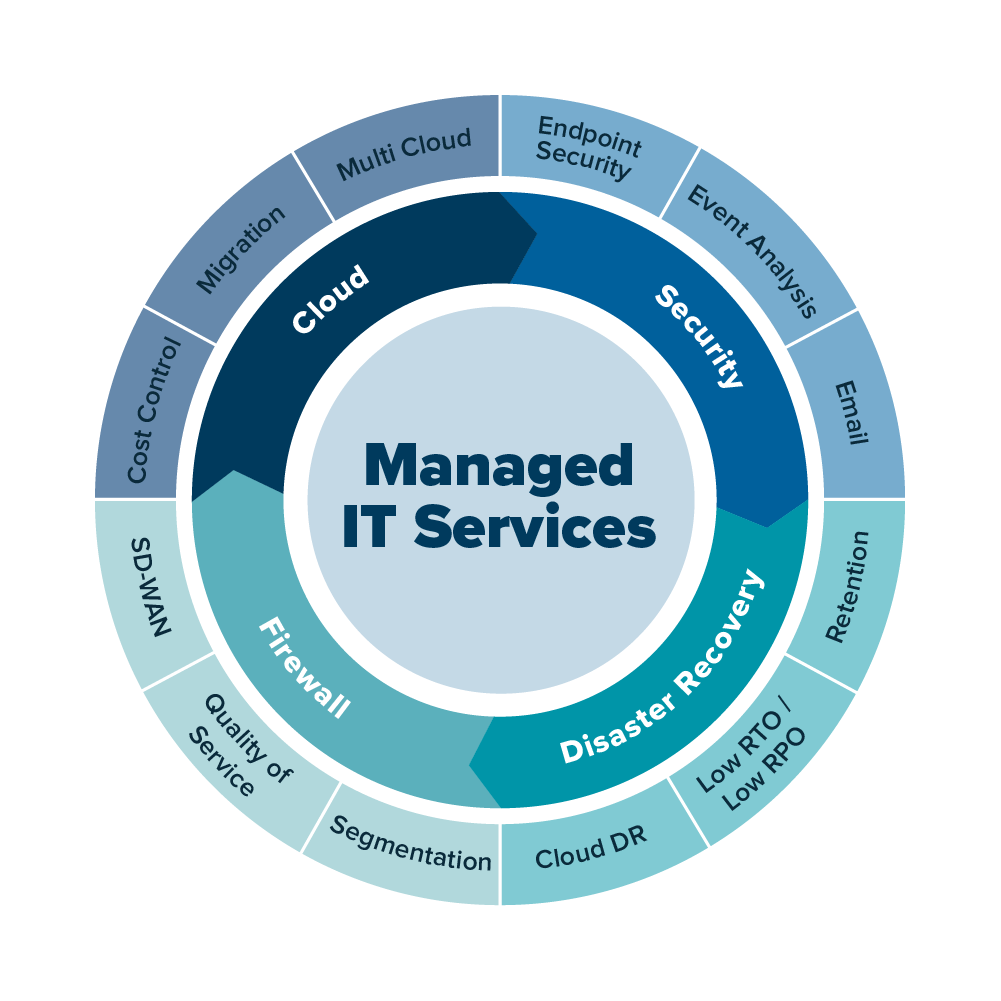Why Your Company Demands Trusted Managed IT Services
Why Your Company Demands Trusted Managed IT Services
Blog Article
Why Every Organization Must Consider Managed IT Providers to Make Sure Continual System Tracking and Maintenance
In today's quickly evolving technical landscape, businesses encounter raising stress to maintain robust IT facilities - Managed IT. The choice to take on handled IT services elevates vital factors to consider pertaining to price, scalability, and the option of a suitable service provider that can line up with particular business demands.
Recognizing Managed IT Services
In today's technology-driven landscape, comprehending handled IT services is essential for organizations looking for to optimize their IT framework. Handled IT solutions describe the method of contracting out certain IT operates to a third-party provider, understood as a Managed Provider (MSP) This design makes it possible for services to focus on their core expertises while guaranteeing that their IT systems are maintained and checked successfully.
Commonly, managed IT solutions incorporate a large range of offerings, consisting of network administration, data back-up and recovery, cybersecurity, and assist desk assistance. By partnering with an MSP, companies can take advantage of specialized proficiency and accessibility to advanced innovations without the expenses costs related to keeping an internal IT division.

Benefits of Continuous Tracking
Continual tracking offers numerous benefits for organizations making use of managed IT services, substantially enhancing their security stance and operational performance. By keeping real-time oversight of IT systems, services can quickly discover and react to potential hazards, lessening the danger of data violations and cyberattacks. This positive strategy to security not only safeguards delicate info yet likewise aids to keep conformity with industry laws.
Furthermore, constant surveillance aids in determining efficiency bottlenecks and system vulnerabilities, enabling prompt interventions that prevent downtime and solution interruptions. This makes sure that IT facilities remains trusted and capable of supporting organization operations seamlessly. MSP. As companies increasingly depend on innovation, the capacity to check system efficiency in real-time becomes essential for maintaining productivity
In addition, constant monitoring enables organizations to optimize resource allotment by offering insights right into usage patterns and system wellness. This data-driven strategy allows for educated decision-making concerning upgrades and investments in IT framework. Ultimately, the advantages of continuous surveillance expand past prompt safety and security enhancements, positioning companies for long-lasting success by promoting a durable and efficient functional setting.
Proactive Upkeep Approaches
Frequently implementing positive maintenance approaches is vital for companies making use of managed IT solutions to make sure ideal efficiency and reduce the threat of unanticipated failings. These methods include organized strategies that concentrate on recognizing and resolving potential issues before they intensify into considerable issues.
One trick approach is routine system updates and patch administration, which assist shield against vulnerabilities that could be exploited by cyber threats (Managed IT). Making sure that software application and hardware elements are updated not just enhances security but also boosts total system functionality
In addition, regular performance assessments can identify traffic jams and inadequacies. By examining system performance metrics, IT teams can make educated see page choices around necessary upgrades or source reallocations. Moreover, establishing a routine timetable for data backups is vital to safeguarding important details and making sure service continuity.
Training personnel in finest practices for modern technology usage is another positive step that minimizes human error, which is frequently a considerable consider system downtime. Inevitably, adopting a positive maintenance culture fosters a resilient IT environment that supports company objectives and improves total performance. Via these methods, organizations can effectively minimize threats and ensure a durable IT infrastructure.
Cost-Effectiveness of Managed Solutions
Proactive maintenance techniques not just enhance system dependability yet also add to the overall cost-effectiveness of managed IT services. By executing routine surveillance and upkeep, services can identify potential problems prior to they rise, therefore minimizing the probability of costly downtime and emergency fixings. This preventative strategy makes it possible for organizations to assign their funds much more effectively, as they can prevent unforeseen expenditures connected with system failures.
Additionally, managed IT solutions commonly supply foreseeable pricing models, permitting organizations to budget plan successfully. MSPAA. Unlike standard IT setups, where expenses can vary significantly because of unpredicted problems, handled services supply a clear understanding of continuous expenses. This transparency aids in economic preparation, ensuring that firms can purchase other essential areas of their operations
In addition, outsourcing IT management to a specialized provider can lead to significant financial savings in labor costs and training costs. Companies no longer need to work with and keep a full in-house IT group, which minimizes expenses. Eventually, the assimilation of managed IT solutions promotes a more lasting economic model for services, enabling them to concentrate on growth while guaranteeing their innovation infrastructure remains robust and effective.

Choosing the Right Service Provider
When assessing managed IT services, picking the appropriate provider is crucial for optimizing the benefits of your investment. An appropriate company not just enhances your functional effectiveness however likewise lines up with your service objectives and needs. Begin by reviewing their experience and proficiency in your particular market; suppliers with a deep understanding of your field will certainly be much better equipped to address one-of-a-kind obstacles.
Following, consider their variety of solutions. A detailed carrier needs to supply aggressive tracking, upkeep, and assistance, making certain alternative protection of your IT framework. Additionally, scalability is crucial; as your business grows, your IT needs will advance, and your company needs to be able to adjust accordingly.

Last but not least, openness in pricing and solutions is important. A respectable carrier will plainly detail their offerings and costs, allowing you to make informed choices without covert charges. By meticulously thinking about these aspects, your business can protect a handled IT solution provider that fosters development and development.
Conclusion
In final thought, the implementation of managed IT solutions emerges as a critical necessity for businesses aiming to improve functional efficiency. Inevitably, selecting the suitable managed IT company is important for promoting a resilient IT framework capable of supporting continual development.
Report this page